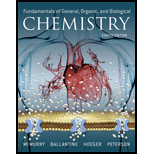
Pearson eText Fundamentals of General, Organic, and Biological Chemistry -- Instant Access (Pearson+)
8th Edition
ISBN: 9780135213759
Author: John McMurry, David Ballantine
Publisher: PEARSON+
expand_more
expand_more
format_list_bulleted
Question
Chapter 28, Problem 28.51AP
Interpretation Introduction
Interpretation:
The three primary female sex hormones have to be determined.
Concept Introduction:
Steroid: Steroids are a type of organic compound having a molecular structure with four rings connected to each other.
There are three types of steroids. They are mineralcorticoids, glucocorticoids and sex hormones.
Expert Solution & Answer
Want to see the full answer?
Check out a sample textbook solution
Students have asked these similar questions
Name the three principal female sex hormones.
Name the two primary male sex hormones.
Name the three most important female sex hormones.
Chapter 28 Solutions
Pearson eText Fundamentals of General, Organic, and Biological Chemistry -- Instant Access (Pearson+)
Ch. 28.1 - While thinking about how a messenger molecule and...Ch. 28.2 - Prob. 28.2PCh. 28.2 - Prob. 28.3PCh. 28.2 - Prob. 28.4PCh. 28.3 - Prob. 28.5PCh. 28.3 - Prob. 28.6KCPCh. 28.4 - Prob. 28.7PCh. 28.4 - Look at the structure of thyroxine shown earlier...Ch. 28.4 - Prob. 28.1CIAPCh. 28.4 - Prob. 28.2CIAP
Ch. 28.4 - Prob. 28.9PCh. 28.5 - Prob. 25.10PCh. 28.6 - Prob. 28.11PCh. 28.6 - Prob. 28.12PCh. 28.6 - Prob. 28.13KCPCh. 28.7 - Identify the functional groups present in THC. Is...Ch. 28.7 - Prob. 28.15KCPCh. 28 - Prob. 28.16UKCCh. 28 - Prob. 28.17UKCCh. 28 - Prob. 28.18UKCCh. 28 - Prob. 28.19UKCCh. 28 - Prob. 28.20UKCCh. 28 - Prob. 28.21UKCCh. 28 - Prob. 28.22APCh. 28 - Prob. 28.23APCh. 28 - Prob. 28.24APCh. 28 - Prob. 28.25APCh. 28 - Prob. 28.26APCh. 28 - Prob. 28.27APCh. 28 - Prob. 28.28APCh. 28 - Prob. 28.29APCh. 28 - Prob. 28.30APCh. 28 - Prob. 28.31APCh. 28 - Prob. 28.32APCh. 28 - Prob. 28.34APCh. 28 - Prob. 28.35APCh. 28 - Prob. 28.36APCh. 28 - Prob. 28.37APCh. 28 - How does epinephrine reach its target tissues?Ch. 28 - Prob. 28.39APCh. 28 - Prob. 28.40APCh. 28 - Prob. 28.41APCh. 28 - Prob. 28.42APCh. 28 - What enzyme catalyzes hydrolysis of the second...Ch. 28 - Prob. 28.44APCh. 28 - Prob. 28.45APCh. 28 - Prob. 28.46APCh. 28 - Prob. 28.47APCh. 28 - Prob. 28.48APCh. 28 - Prob. 28.49APCh. 28 - Prob. 28.50APCh. 28 - Prob. 28.51APCh. 28 - Prob. 28.52APCh. 28 - Prob. 28.53APCh. 28 - Prob. 28.54APCh. 28 - Prob. 28.55APCh. 28 - Prob. 28.56APCh. 28 - Prob. 28.57APCh. 28 - Prob. 28.58APCh. 28 - Prob. 28.59APCh. 28 - Prob. 28.60APCh. 28 - Prob. 28.62APCh. 28 - Prob. 28.63APCh. 28 - Prob. 28.64APCh. 28 - Prob. 28.65APCh. 28 - Prob. 28.66APCh. 28 - Prob. 28.67APCh. 28 - Prob. 28.68APCh. 28 - Prob. 28.69APCh. 28 - Prob. 28.70APCh. 28 - Prob. 28.71APCh. 28 - Prob. 28.72APCh. 28 - Prob. 28.73APCh. 28 - Prob. 28.74APCh. 28 - Prob. 28.75APCh. 28 - Prob. 28.76APCh. 28 - Why do we have brain receptors that respond to...Ch. 28 - Prob. 28.78APCh. 28 - Prob. 28.79APCh. 28 - Prob. 28.80APCh. 28 - Prob. 28.81APCh. 28 - Prob. 28.82APCh. 28 - Prob. 28.83CPCh. 28 - Prob. 28.84CPCh. 28 - Prob. 28.85CPCh. 28 - Prob. 28.86CPCh. 28 - Prob. 28.87CPCh. 28 - Prob. 28.88CPCh. 28 - Prob. 28.89CPCh. 28 - Prob. 28.90CPCh. 28 - Prob. 28.91CPCh. 28 - Prob. 28.92CPCh. 28 - Prob. 28.93CPCh. 28 - Prob. 28.94GPCh. 28 - Prob. 28.95GP
Knowledge Booster
Similar questions
- Identify which of the following hormone categories are lipid-soluble: (a) reproductive hormones produced in the gonads, (b) adrenal cortex hormones, and (c) thyroid hormone.arrow_forwardName one hormone produced by each of the following organs—the heart, liver, and placenta—and state the function of each hormone?.arrow_forwardDefine progesterone.arrow_forward
arrow_back_ios
SEE MORE QUESTIONS
arrow_forward_ios
Recommended textbooks for you
 Human Physiology: From Cells to Systems (MindTap ...BiologyISBN:9781285866932Author:Lauralee SherwoodPublisher:Cengage Learning
Human Physiology: From Cells to Systems (MindTap ...BiologyISBN:9781285866932Author:Lauralee SherwoodPublisher:Cengage Learning

Human Physiology: From Cells to Systems (MindTap ...
Biology
ISBN:9781285866932
Author:Lauralee Sherwood
Publisher:Cengage Learning